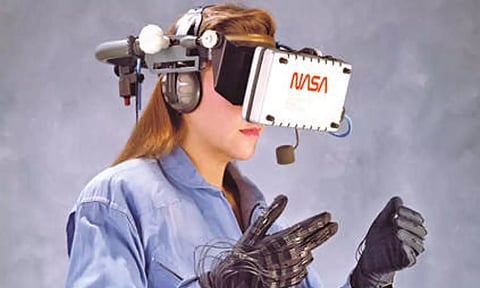

• KENNETH CHANG
NEW YORK: Last month, NASA welcomed Richard Danne to its headquarters in Washington to celebrate work he had done nearly half a century ago. Danne never studied the stars. He never built a rocket. But he and his design partner, Bruce Blackburn, came up with one of the most recognizable elements of the space agency: the logo known as the “worm,” with the acronym N-A-S-A spelled out in bold, sinewy, orange-red letterforms.
The worm endures, even though NASA dumped it more than 30 years ago, returning to “the meatball” — its original logo, with a blue circle, stars, an elliptical orbit trail and a swoosh representing an airplane wing. In the past few years the worm’s clean, futuristic look has experienced a renaissance inside and outside the space agency; it is now prominently splayed on the sides of spacecraft, T-shirts, sneakers and souvenirs.
This summer it became three-dimensional, a massive sculpture in front of NASA headquarters and a picturesque background for tourist snapshots. “I love being part of pop culture,” said Danne, 89.
Look at some of NASA’s recent spacecraft, like the Orion capsule that went around the moon last year, and you’ll see an unexpected mash-up of the two logos.
“Some might say they come from different planets,” David Rager, NASA’s creative director, said during the event that celebrated Danne and the worm last month. For half a century, it was one logo or the other at the space agency. NASA started using the meatball in 1959, a year after its founding. It was the logo on Neil Armstrong’s spacesuit when he stepped on the moon in 1969.
The worm is a child of the 70s. A small, newly formed design firm, Danne & Blackburn, won a contract from the National Endowment for the Arts when that body was seeking to give federal agencies a visual remake. Blackburn, who had designed the symbol used to mark America’s bicentennial celebration, played with various pictorial approaches, but settled on a futuristic take on the four letters of NASA. The two As, prominently lacking crossbars, suggested rocket noses, or engine nozzles. “It was extremely simple,” Blackburn said in 2015. (He died in 2021.) “It was direct.”
The work delivered to NASA by Danne and Blackburn went far beyond just a four-letter logo. They also put together a compendium of dos and don’ts — the proper size and usage of the logo, placement of any accompanying text, the specific shade of red. The graphics standards manual sought to give a cohesive appearance across the agency and its centers around the country.
“This is something that didn’t exist prior to our redesign,” Danne said. “The publications and forms were quite a mess, radically uneven in both language and appearance.” Danne said much of the work was devoted to the visual decluttering of the NASA organization. They rewrote NASA’s forms to make them shorter and clearer, and those shorter forms saved on printing costs. They specified standardized layouts, with limited combinations of fonts, which allowed NASA to put out publications more quickly.
“The fact that it looked better was kind of frosting on the cake,” Danne said during the panel discussion.